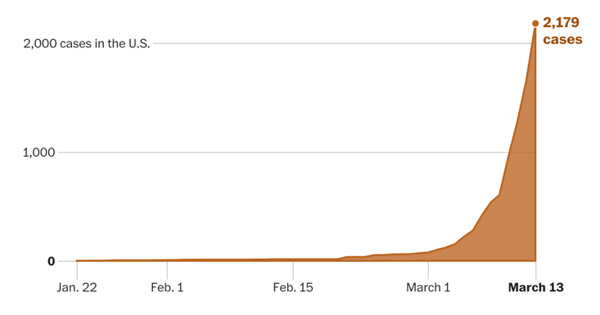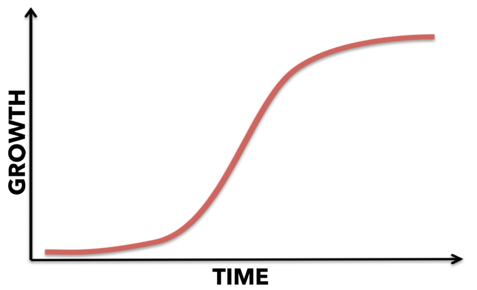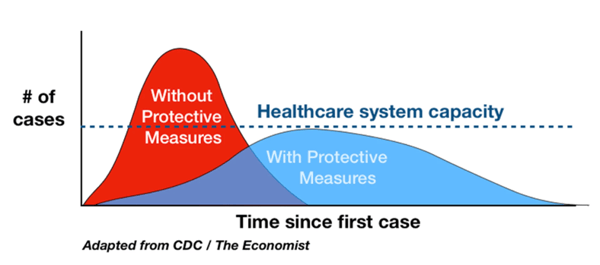
This blog is a look at the exponential growth curves and implications of COVID-19.
Today we are witnessing the viral spread of fear that is definitively damaging both national economies and global markets. My heart goes out to those small businesses that are hardest hit (or will soon be closed), to those who are losing their jobs or facing the uncertainty of unpaid leave, to single-parent households struggling to support children’s online education at home, for the healthcare workers on double shifts and to those whose nest-egg savings are evaporating.
Personally, I’ve been heads down in research and conversations to distinguish “Fear from Reality.”
It’s important for me to admit to my readers that in the past 10 days, my concern about the infection and mortality rates of Coronavirus has significantly increased. However, I do maintain my position that the level of panic is doing as much damage.
(Note: If you like this blog, share it! | Facebook | Twitter | LinkedIn | Read on Diamandis.com | Or send your friends and family to this link to subscribe!)
As a surge of accurate data emerges and gets interpreted by top scientists, it is now evident that the fatality figures of COVID-19 are significantly greater than those of the annual flu.
The CDC estimates that influenza was associated with more than 35.5 million illnesses, and 34,200 deaths during the 2018-2019 influenza season, which equates to a 0.1% mortality rate.
By contrast, as of March 9, 2020, here are the comparative mortality rates for the top 4 infected nations (Source: Johns Hopkins University):
Country Cases Deaths Mortality %
China 80,738 3,120 3.9%
S. Korea 7,478 53 0.7%
Italy 7,375 365 5.0%
Iran 6,566 194 3.0%
Please NOTE that these mortality rates may be significantly inflated. Why?
While the death of a patient is an absolute measurable endpoint, given the lack of comprehensive and accurate testing, and the fact that many patients are asymptomatic, or have minor symptoms, there could be a much larger population of infected people than is being reported.
So, for example, if Italy’s ‘infected population’ was actually 5x bigger, then mortality rate would be 5x lower.
#1: Implications of Exponential Growth
Given the asymptomatic latency period between the time a person is infected and the time that they show symptoms (which may be as little as 5 days or up to 14), PLUS the high airborne transmission rate of the virus (and long survival times on surfaces), we are likely to see significant exponential growth rates in the early days of an outbreak until “herd immunity” can be established.
(Note: Herd Immunity occurs when enough people have been infected and then recover, making them immune to being re-infected and infecting others in their community.)
Data analysis and recent reports (here) lead to the estimate of “doubling times” for infected populations of somewhere between 3 to 6 days. (For Italy, the rate is 5 days, while in the US, France, and Germany, it has been 3 days).
This high rate of geometric growth (doublings every 4-6 days) is likely in the early days and will plateau (i.e. it’s easy to double small numbers, but eventually other factors, such as herd immunity, slow rates dramatically).
But what does a doubling time of 4 days actually mean? If we have 100 people infected today, 4 days later we will see 200, and another 4 days later, we've reached 400.
An exponential is a simple doubling: 1, 2, 4, 8, 16, 32, 64, 128… etc.
But exponential growth curves are deceptive. Our minds evolved in a linear world, and we don’t fully ‘grok’ things that are exponential.
For reference, please remember the following:
- Double something 10 times and its 1,000 x bigger.
- Double something 20 times and its 1 million x bigger.
- Double something 30 times and its 1 billion x bigger.
For example: Let’s assume that there are 100 infected people today, and the doubling rate is 4 days. That means that in 20 doublings (80 days = 2.67 months), there could be as many as 100 million people infected by the end of May.
 Source: Washington Post
Source: Washington Post
So, what is the worst-case scenario? (And I stress that I believe this is the worst-case scenario.) German Chancellor Angela Merkel explained that 70 percent of Germany’s population could become infected. From a US perspective, concerning 327 million residents, many predict that as many as 50% (or more) of Americans could be infected over the next 18 months.
If the mortality rate is 1%, that means we could see somewhere on the order of at least 1.5 million deaths from this pandemic (projected from UCSF).
To put this in perspective, last year the U.S. saw a total of 2.8 million people die from all combined medical causes (cancer, heart disease, suicide, etc.).
Also, for reference (and perspective), here are the data on “Deaths per Day Worldwide” (and per year) from various infectious diseases on a global basis:
Global Deaths Per Day Per Year
Tuberculosis… 3,014 1.1 million
Hepatitis B… 2,430 887,000
Pneumonia… 2,216 819,000
HIV/AIDS… 2,110 766,500
Malaria… 2,002 730,000
Shigellosis… 1,644 600,000
Rotavirus… 1,233 450,000
Seasonal Flu… 1,027 375,000
Norovirus… 548 200,000
Whooping Cough… 440 160,000
Typhoid… 396 145,000
Cholera… 392 143,000
Others… (less than 300) - - - -
Coronavirus… 50 – 80 - - - -
PLEASE CHECK THIS OUT >>> And to offer you a final insight into exponential growth, take a look at the “Corona Simulator” graphics page set up by the Washington Post. It is excellent and will help you intuitively understand what exponential "feels like."
#2: Evidence of a Slow Down?
Please note that there is evidence that Coronavirus is slowing down. In a recent article on the work and predictions of Nobel Laureate and Stanford professor Michael Levitt, journalist Ari Libsker explains:
“But then, the trend changed. When Levitt started analyzing the data on February 1, Hubei had 1,800 new cases each day and within six days this number reached 4,700, [Levitt] said.” In Levitt’s words, “And then, on February 7, the number of new infections started to drop linearly and did not stop. A week later, the same happened with the number of the deaths. This dramatic change in the curve marked the median point and enabled better prediction of when the pandemic will end. Based on that, I concluded that the situation in all of China will improve within two weeks. And, indeed, now there are very few new infection cases."
Such a slowdown comes naturally in all exponential systems, sometimes from factors like herd immunity, sometimes from the exhaustion of resources. This is typically referred to as an "S-CURVE."

Sometimes the change occurs because of proactive efforts. Wuhan in particular—and China as a whole—has exercised an extraordinarily fast and radically effective response, influencing both individual behavior and institutional efforts.
As discussed widely, society’s ability to “flatten the Coronavirus curve”—or limit the number of infections by reducing spread, is crucially important for achieving a general slowdown.
 Source: The New York Times
Source: The New York Times
Tomorrow, I’ll be publishing an edited repost of an article featuring China’s top tactics for containment and high-tech strategies for ensuring a slowdown.
With Pause, Comes Opportunity…
Never allow a crisis to go to waste…
For many who are working from home, or have paid leave, or have the means to avoid panic, the situation at hand offers some re-invention opportunities.
Here are the thoughts/questions I’m personally focusing on:
- Increased time with family: Having meaningful discussions brought to light by this global crisis. How are you using this time to better connect with the people you love?
- Focus on self: Key to surviving Coronavirus is a healthy immune system, which comes from sleep, meditation, stress reduction and exercise. How are you using this time to take care of your physical and emotional life?
- Re-inventing your business: Could this be the time your company ditches your legacy business model and pivots into a more profitable niche post-Coronavirus?
- Taking your company digital: COVID-19 will accelerate our digital lives. Here’s a chance to digitize, dematerialize, demonetize and democratize every aspect of your business… education, healthcare, products and services. How are you using this time to re-invent how you deliver your business’ products and services in a fully digitized way?
- Creating new businesses to help the world: As I teach my Abundance360 and Singularity University graduates, “The world’s biggest problems, are the world’s biggest business opportunities.” How could you use emerging exponential technologies (Artificial Intelligence, robotics, 3D printing, smart sensors, networks, Augmented Reality & Virtual Reality) to help prevent pandemics and tackle the resulting implications?
I hope this piece will prove useful and thought-provoking, and to start a conversation over the course of this week, while we collectively practice social distancing and push forward.
Warmest wishes for your health, safety and peace of mind.
Peter
(Note: If you like this blog, share it! | Facebook | Twitter | LinkedIn | Read on Diamandis.com | Or send your friends and family to this link to subscribe!)
Join Me
(1) A360 Executive Mastermind: If you’re an exponentially and abundance-minded entrepreneur who would like coaching directly from me, consider joining my Abundance 360 Mastermind, a highly selective community of 360 CEOs and entrepreneurs who I coach for 3 days every January in Beverly Hills, Ca. Through A360, I provide my members with context and clarity about how converging exponential technologies will transform every industry. I’m committed to running A360 for the course of an ongoing 25-year journey as a “countdown to the Singularity.”
If you’d like to learn more and consider joining our 2021 membership, apply here.
(2) Abundance Digital Online Community: I’ve also created a Digital/Online community of bold, abundance-minded entrepreneurs called Abundance Digital. Abundance Digital is Singularity University's ‘onramp’ for exponential entrepreneurs — those who want to get involved and play at a higher level. Click here to learn more.
(Both A360 and Abundance Digital are part of Singularity University — your participation opens you to a global community.)







